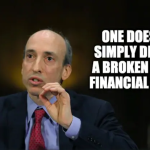The debt ceiling, also known as the debt limit, is a statutory limit set by the United States Congress on the amount of debt that the U.S. Treasury can issue to finance the federal government’s spending obligations. It is the maximum amount of money that the U.S. government is allowed to borrow to meet its financial obligations, including paying its bills, servicing its existing debt, and funding government programs.
The debt ceiling is authorized by Congress and enforced by the Treasury Department. When the debt reaches the limit set by Congress, the Treasury Department is not allowed to issue additional debt, which may result in the federal government facing a potential default on its financial obligations. In order to continue borrowing beyond the debt ceiling, Congress must pass legislation to raise or suspend the debt limit.
The debt ceiling has been a topic of political debate and contention in the United States, with discussions often revolving around issues of fiscal responsibility, government spending, and the national debt. Failure to raise or suspend the debt ceiling in a timely manner could have significant consequences for the U.S. economy and financial markets, potentially leading to disruptions in government operations, delays in payments, increased borrowing costs, and damage to the country’s credit rating. As a result, the debt ceiling is an important aspect of the U.S. government’s fiscal policy and has significant implications for the country’s financial and economic stability.
| Debt Ceiling Drama Risks Market Turmoil |
| With the banking crisis still fresh in our minds, the U.S. economy and markets face another potential shock later in the year as the government looks likely to hit the debt ceiling. Although future government cashflows can vary a lot, depending on things like project spending, hiring and tax receipts, Moody’s had estimated the date the debt limit could be breached around August (sometimes called the X Date, Chart 1), but weaker-than-expected tax collections mean it could come as soon as June. |
| Chart 1: Estimated track of U.S. government to reach their debt limit |
 |
| Households know what happens when they hit the limits on their credit cards and have no more money in the bank. But what does this mean when a government (that can print money) does it? A look at the history of hitting the debt ceiling could be helpful. |
| Until 2011, the debt ceiling was increased as a matter of course |
| For much of U.S. history, the debt ceiling was increased without incident. In fact, the debt ceiling dates back to 1939, when Congress consolidated multiple forms of debt into one aggregate debt limit. From there, the debt limit (Chart 2, blue line) has consistently increased each time outstanding public debt (red area) approached the limit. Once it was actually lowered in 1946 after the end of World War II and in the late 1990s, government surpluses meant it didn’t need to be raised for a number of years. Since 1960, the debt limit has been raised, in some manner, 78 times – 49 times under Republican presidents and 29 times under Democratic presidents – in order to avoid default on Treasury interest payments and to keep the government running. |
| Chart 2: U.S. debt has increased significantly in recent years |
 |
| Still, there were occasional issues. For instance, a six-month squabble over raising the debt ceiling in 1957 saw the Air Force not pay its bills for a while. There was also a close call in 1979 where the Treasury Department delayed payments on Treasury bills. That led to the adoption of the Gephardt Rule, allowing the House to automatically raise the debt limit via budget resolution without requiring a separate vote. This rule has been used 15 times to increase the debt limit. However, since the repeal of the Gephardt Rule in 2011, we’ve seen drawn-out battles over raising the debt ceiling in 2011, 2013, and 2021. Importantly, the 2011 episode even resulted in S&P downgrading the U.S.’s credit rating from AAA to AA+ (green line) – where it remains. It looks like 2023 is set for another showdown. |
| The debt limit is a blunt tool to set the U.S. on a more sustainable debt path |
| Part of the debate over the debt limit is about setting the U.S. on a more sustainable debt path, especially after a few years that saw historic deficit spending in response to the pandemic. Federal government debt is currently around 100% of the U.S.’s gross domestic product (GDP), a level it has not seen since the end of World War II (Chart 3, navy blue line). However, after the 1945 peak, the debt ratio fell, getting to just 23% by 1974. Although, we highlight that during that time, debt still increased by 80%. It’s just that GDP grew nearly 600% over the same time. Since then, debt has grown 6,400%, while GDP is up a comparatively small 1,500%. Thanks to things like the aging U.S. population, which will add to costs for programs like Medicare and Social Security while likely slowing economic growth, the U.S. Congressional Budget Office (CBO) recently projected the U.S.’s debt-to-GDP ratio will almost double by 2050 (light blue line). |
| Chart 3: U.S. debt on path to “becoming Japan” |
 |
| Interestingly, Japan offers an interesting historic parallel to the U.S. forecasts. Japan increased debt levels above 100% back in the ‘90s as demographics forced their own workforce to shrink. Today, the debt-to-GDP ratio in Japan stands at about 260%. In large part, that is “sustainable” thanks to the Bank of Japan (BOJ) buying Japanese government debt, so the BOJ’s demand help keeps interest rate lows. The BOJ now owns more than half of all Japanese government bonds. By buying bonds from itself, it effectively adds cash to the system, which is similar to what the Covid stimulus checks did in the U.S. Economic theory says that if there is more money but not a rise in output, prices will rise to effectively soak up the extra money. However, as we wrote about before, aging populations and falling workforces work the other way — to slow demand — and can (as Japan and arguably Europe and, to a degree, the U.S. have found) become deflationary. Even if Japan shows such high debt can be sustained, research shows it becomes a drag on economic growth once debt-to-GDP tops 77%. Plus, the CBO projects U.S. net interest costs would more than quadruple to 7.2% of GDP by 2052, accounting for nearly 40% of federal revenues – compared to around 10% today. This brings us back to the current U.S. situation. |
| Markets see 2023 as the greatest risk of default yet |
| U.S. debt technically hit its $31.4 trillion debt limit in January 2023. The U.S. hasn’t defaulted yet because the U.S. Treasury has implemented accounting maneuvers and other extraordinary measures, including reducing investments in federal employee retirement plans, to fund the government’s debt until the “X Date” arrives. The X Date is when extraordinary measures are exhausted, and the government defaults on its debt (fails to pay the interest due). Markets have devised ways to insure against bonds that fail to make interest payments – known as credit default swaps (CDS). CDS prices represent the cost to insure debt against default and can be used to measure the risk of a default occurring. CDS spreads on U.S. Treasuries recently hit record highs, even higher now than in past debt ceiling debates (chart below). |
| Chart 4: Markets are pricing in record-high odds the U.S. government will default on its debt |
 |
| Interestingly, the chart also shows that CDS spreads were comparatively muted in 2021 – why? It’s partly due to the fact that a single party controlled the government, with the presidency and a majority in both houses of Congress (Chart 5). That makes it relatively easier to push through a debt ceiling increase. |
| Chart 5: Divided government tends to make increasing the debt ceiling more fraught |
 |
| However, in 2023 we have a split congress, more like in 2011 and 2013. Some say this could result in the toughest debt debate yet, with both sides far apart on this issue currently, something the CDS market seems to support. |
| Will we default, and what would default mean? |
| Despite this, many expect a last-minute (or last-second) deal because the cost of default is simply too high. Moody’s estimates that just a weeks-long breach of the debt limit would cause an almost-immediate and severe recession, resulting in seven million jobs lost and a nearly-20% drop in equity prices. That’s because, no longer able to spend more than it takes in, the government would have to slash outlays immediately – cutting about $350 billion in deficit spending and furloughing government workers without pay. It is also likely that U.S. debt would be downgraded (again), increasing our future funding costs and reducing asset values. Consumer, business, and investor confidence could plummet, further curtailing spending and investment. |
| Past experience tells us to expect bond market turmoil |
| Even a close call is not necessarily without costs, as we saw in 2011 when S&P downgraded the U.S.’s credit rating. In the next few charts, we plot different market reactions to the debt ceiling crisis in 2011, 2013 and 2021. The research shows short-term Treasuries are particularly sensitive to a debt ceiling showdown. Even without the debt ceiling being breached, interest rates spike on short-term debt as investors avoid exposure to potential default: 2013 (green line) saw the sharpest increase, with yields rising 35 basis points over a couple of weeks prior to the X Date. Recall that in 2013 the debt ceiling debate resulted in the Federal government shutting down from October 1 until October 16 – with the furloughing of all non-essential federal workers – until Congress reopened the government and increased the debt limit just hours before the X Date.In contrast, in 2011 (blue line), a government shutdown was averted, and the increases in yields were correspondingly smaller – with one-month T-bills rates rising 16 basis points over the couple weeks prior to the X Date. 2021 (orange line) saw a short-term resolution to temporarily fund the government pass four days before the first X Date. An initial increase in rates subsided, only to rise again as the second X Date approached (orange dashed line) a couple of months later. As that second X Date approached in late 2021, we saw another 8-basis point increase in the one-month T-bill yield. |
| Chart 6: Short-term Treasury yields rise noticeably ahead of the X Date |
 |
| Interestingly, 10-year Treasury yields actually fell ahead of the X Date in 2011 and, to a lesser extent, in 2013, reflecting a flight to safety and the expectation that any default would be short-lived. In reality, a crisis was averted in all three cases, with the government able to increase or suspend the debt limit before the X Date, preventing default. We immediately see sharp drops in yields, back to prior levels, in each case. |
| Other financial assets have less consistent reactions to debt ceiling showdowns |
| Given the debt ceiling crisis affects short-term government bond interest rates, it is interesting to look at the MOVE Index, a measure of bond market volatility. The MOVE Index’s average since the early 2000s is about 85. Notably:It was around that level in 2011 (Chart 7, navy line).Far below it in 2021 (orange line).Far higher coming into the 2013 debt crisis (green line). Although those dates overlapped with the more impactful fallout from the “taper tantrum” (where the Fed announced future plans to reduce quantitative easing or bond purchases), which saw 10-year Treasury yields increase nearly 100 basis points between May and December 2013.In short, the MOVE index seems to have an inconsistent reaction to debt crises. That’s likely because the MOVE Index is mostly driven by the implied volatility of longer-term Treasuries, from 2 to 30 years. And as we noted above, those longer-term Treasuries are much less impacted by debt ceiling drama. |
| Chart 7: Bond market volatility is also muted since it’s based on longer-term Treasuries |
 |
| A similar index for equities is the VIX equity volatility index. The data shows that VIX reacts earlier than the bond market:In 2011, the VIX rose ahead of the X Date and then spiked above 45 after the X Date.In contrast, in the run-up to the 2013 X Date, the VIX rose from under 15 to over 20.In 2021, the VIX doubled, reaching above 30, as the second X Date approached |
| Chart 8: Equity market volatility is surprisingly muted ahead of the X Date historically |
 |
| What made the 2011 crisis different for stocks? Importantly, this was the debt ceiling crisis that led to the U.S. credit rating downgrades by S&P. At the same, time there were concerns about the U.S. slipping into a recession and risks of potential spillover from the European sovereign debt crisis. As a result, the stock market sold off significantly, falling 17% (chart below, navy line). In contrast, in 2013 (green line) and 2021 (orange line), the S&P 500 saw selloffs ahead of the respective X Dates, with another 4% selloff in 2021 as tensions again increased around the second X Date. |
| Chart 9: The X Date has been less important than other factors to S&P 500 returns |
 |
| What does this all mean? |
| U.S. debt levels have been increasing much faster than GDP, especially since the Credit Crisis in 2008. That’s added to the challenges of raising the debt ceiling and caused three significant short (and some would say unnecessary) financial stresses since 2011. Data show that short-term bonds have the most predictable reaction – with interest rates and default insurance costs rising significantly – before quickly returning to normal after the uncertainty has passed. The uncertainty around debt ceiling debates also causes stocks to sell off, sometimes with a dramatic increase in volatility. Other research shows that it’s especially unhelpful for companies about to IPO, which could have lasting impacts on capital formation and the attraction of public markets to private companies. As we get nearer to August, we could also see the economy and earnings slowing. As this issue gets more urgent and thus attracts more attention, there is a risk that government gridlock could cause real harm to companies and investors. Michael Normyle, U.S. Economist at Nasdaq, contributed to this article. |









